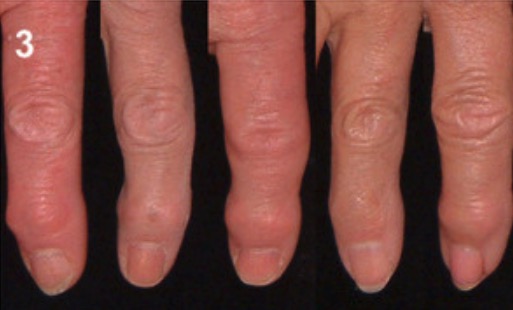Playlist
Show Playlist
Hide Playlist
Osteoarthritis (OA)
-
Rheumatology I 01 Non-Autoimmune Arthritis.pdf
-
Download Lecture Overview
00:02 Continue our discussion of Rheumatology. We'll take a look at rheumatic diseases. 00:07 Under rheumatic disease, our category include non-autoimmune arthritis. Now, the first example that we're going to walk you through is going to be osteoarthritis. But, very importantly, you need to be able to compare this with rheumatoid arthritis. 00:24 So, how do we approach arthritis in general? With joint pain is going to be a common symptom, except that doesn't tell you much. 00:31 Apart from the fact that, "Oh, yeah, I have issues in the knee," Most likely, I'm going to go with what most likely. 00:37 Also, we're going to pay attention to those joints that most likely will lead you into the proper diagnosis. 00:45 What's the difference between arthritis versus arthralgia? Algia refers to pain, whereas itis refers to well, inflammatory, but even that can be a little tricky, you shall see. But technically speaking, there is a difference in definition between the two. 01:05 Arthralgia, sensation of pain, but understand that the pain oftentimes is accompanied by the arthritis, perhaps, maybe around the joint or periarticular. 01:18 Next, we'll be defining what's meant by acute and chronic, especially, for example, we talk about crystalline arthritis, for example, gout. 01:29 We'll talk about acute and chronic gout or talk about issues even with pseudo gout, what that means. 01:36 So what are the common joints that are to be affected? Well, the small joints. That's a big, big, big, big deal. 01:42 Small joints. What do you mean small joints? Oh, maybe the fingers. 01:45 Those are really tiny, huh? I want you to put out your hand for me. 01:49 Can you reach out? There you are. 01:51 Now, what I'm reaching out for is going to be the DIP. 01:55 Picture that for me. 01:56 Distal interphalangeal joint. Huh. 01:59 So if in osteoarthritis DIP is affected, technically, do you remember what the name of that is? If you've never seen it before, then you have no idea, but it's called Heberden nodes. 02:08 Heberden, DIP. Picture that. 02:12 What's a little bit proximal to it? How about we call that PIP? Ha ha. That's brilliant. 02:17 Proximal interphalangeal joint. 02:18 Those are called Bouchard's nodes, okay? So those are 2 joints. Quite specific. 02:25 Usually going to be asymmetrical. 02:27 What else might be affected? Can you…thumb up? Give me a thumbs up because you're doing well. You're getting this down. 02:34 No. Seriously speaking, that is your first digit. 02:37 Can you picture the carpometacarpal? CMC stand for carpal. 02:41 What are your carpal bones? Think, for example, the trapezium. 02:44 Can you picture the trapezium for me? Now, that, plus your metacarpal is your joint. 02:50 Interesting enough, the thumb joint, carpometacarpal phalangeal joint be affected by osteoarthritis. 02:57 So what I'm trying to give to you is the foundation of comparing osteoarthritis with rheumatoid arthritis that we'll discuss, moving forward. 03:05 Small joints: DIP, PIP, carpal metacarpal. 03:08 You're focusing upon the thumb, the knees, as I told you. Obviously, over a period of time, let's say the patient is 45, 50, 55, whatnot. 03:17 As I stand here, I know I'm developing osteoarthritis. 03:20 I'm putting a lot of strain on my knees. 03:24 Hips, and maybe the spine. 03:27 At this point, give yourself a good example. 03:29 I told you the knee can be affected, but obviously, there are other joints as well.
About the Lecture
The lecture Osteoarthritis (OA) by Carlo Raj, MD is from the course Introduction and Non-Autoimmune Arthritis. It contains the following chapters:
- Rheumatic Diseases
- Introduction to Osteoarthritis
Included Quiz Questions
Bouchard’s nodes are hard bony outgrowths on which of the following joints?
- Proximal interphalangeal joints
- Carpometacarpal joints
- Distal interphalangeal joints
- Metatarsophalangeal joints
- Tarsometatarsal joints
A 60-year-old woman complains of pain and stiffness in the right knee joint which is exacerbated by walking or climbing the stairs and relieved with rest. Which of the following conditions is the most likely diagnosis?
- Osteoarthritis
- Septic arthritis
- Gout
- Rheumatoid arthritis
- Ankylosing spondylitis
Which of the following is NOT advised in a patient with osteoarthritis?
- Avoiding exercise
- Weight reduction
- Nonsteroidal anti-inflammatory drugs
- Chondroitin supplement
- Chondroplasty
Customer reviews
5,0 of 5 stars
| 5 Stars |
|
2 |
| 4 Stars |
|
0 |
| 3 Stars |
|
0 |
| 2 Stars |
|
0 |
| 1 Star |
|
0 |
Very clear , short and great explanation. I really recommend this teacher and his lectures.
It is an area I have always skipped to study well and as such, I am very ignorant of the subject. I really like Dr Raj's approach to getting it to sink.




